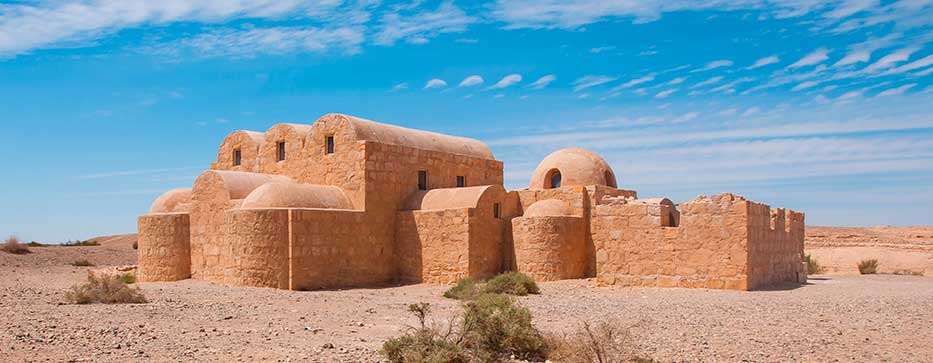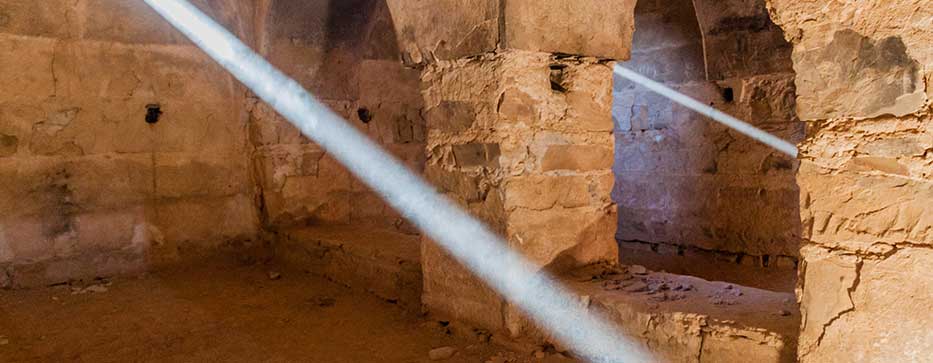Eastern Jordan it is an area that is often left out of the country’s grand circuits, preferring to focus on more famous landmarks in the Highlands or the
Dead Sea
. But this is not the case of our agency: in Jordania Exclusiva we integrate its main attractions in different travel packages, both pre-established and tailor-made, with the ‘Desert castles‘ as the main protagonists. Therefore, on this page we tell you what to see in the East Jordan, how to get here and other information of interest.
Eastern Jordan it is dominated by an immense desert that seems to have no end and that goes into Saudi Arabia, also reaching Iraq. But from a tourist point of view, the Desert of eastern Jordan appears on maps thanks to the so-called ‘desert castles‘.
The most important are at a strategic crossroads: where the caravan routes between Syria, Arabia, Jerusalem and Iraq were located. The largest population in the region is Al Azraq, which has only about 15,000 inhabitants. That, together with the enormous extension of the area (with more than 30,000 km2), causes the feeling of loneliness and stillness to be overwhelming.
The inhospitable and almost lunar landscape that reigns in the region also contributes to this. It is an immense plain with practically no elevations and with oases that appear in droppers, with a rocky terrain where black volcanic rock predominates, mainly basaltic.
During the Neolithic, this region was very different from how it is shown today: its wetlands were much larger and its terrain, much more fertile, which facilitated the settlement of sedentary populations and the work of agriculture.
Greeks and Romans knew the area, and the latter came to occupy it, passing the baton to their Christian successors: the Byzantines between the fifth and eighth centuries. But the main constructive contributions in this territory are due to the new Arab civilization that conquered the region in the mid-eighth century. And in particular, to the Umayyad dynasty, which ruled its huge caliphate from Damascus, leaving here clear signs of its refined culture.
For Abbasid successors, who ruled their rich caliphate from Baghdad, the area also served a strategic role, as it was on the road to Jerusalem. Ayyubids, Mamluks and Ottomans also contributed to consolidate or expand some of the buildings that can still be visited today.
Already in more recent times, the desert of eastern Jordan he has also been closely related to the Arab Rebellion and to the character who made it known in the West: T.E. Lawrence, better known as Lawrence of Arabia. This archaeologist, writer, soldier and lover of Arab culture, member of the troops of Emir Faysal, resided for a winter here, using some of its historical structures, today visitable.
However, since the twentieth century the Jordan’s Eastern Desert It has developed a long tradition of welcoming migrants and refugees fleeing conflicts in their countries: Druze, Chechens, Palestinians, Iraqis and, more recently, Syrians, who have formed a large refugee camp in the vicinity of Al Azraq.
Traveling miles and miles on roads without populations, the traveler might think that there is nothing to see in eastern Jordan. However, the desert holds some surprises for those who have the courage and daring to get here. Those surprises are known as ‘Desert castles‘ which, in reality, are not only historical fortresses, but also caravanserais and hunting lodges. These are the most outstanding that, in fact, are part of some of our circuits.

We don’t have much information about the history of this ‘desert castle‘‘, although it is known that it was known to Greeks and Romans. The Umayyad caliph Walid II used it as a hunting lodge and military fort in the eighth century, but its current appearance is largely due to the expansion of the Ayyubids in the first half of the thirteenth century, used as a defensive place against possible incursions by the Crusaders. It was also used by T.E. Lawrence for a while, and we know the details of that stage thanks to his book.
The seven pillars of wisdom
, which recounts the harshness of winter.
The most representative spaces that can be visited during the visit are:

This castle, declared a World Heritage Site by Unesco, is today in the middle of nowhere, so it has little to do with its original state: it was built next to a wadi that centuries ago was very fertile and full of trees, also fulfilling the function of caravanserai or inn. Its construction was due to the Umayyad caliph Walid I in the early eighth century, one of the great promoters of monuments during the early days of Islam.
However, his successor Walid II, much more puritanical, let it fall out of favor for the excessive daring of its decoration. In the twentieth century it was restored by European archaeologists, including Spanish.
The most attractive thing about Qusayr Amra is, without a doubt, its decoration in the form of frescoes, a rarity for Muslim civilization, which did not take long to censor themes such as those represented here: there are hunting and bathing scenes with naked people, precisely in the rooms that were part of its hammam. In addition, the Fresco of the Six Kings is really original, with mention of some of the great monarchs of the time or previous centuries: among them, the last Visigothic king, Rodrigo, who succumbed in the Iberian Peninsula to the Arab conquerors.
The main places to visit are:

Of all the desert castles, this is the one that has an aspect more like a fortress proper, although its original function is not clear. Some hypotheses propose its use as a caravanserai, while others consider it a gathering pavilion between Arab elites and the nomadic Bedouin population. What seems clear is that it does not respond to a traditional defensive structure, although its semicircular towers suggest so. More than fifty rooms have been identified, perhaps to accommodate the delegations summoned, and it is believed that it could have been built around the year 714.
Unlike the southern desert, where Wadi Rum is located, in the desert of eastern Jordan There is not a wide variety of adventure experiences available to the visitor. On the other hand, the main proposals to make in the area have to do with its nature reserves, which shows different characteristics from each other and, therefore, differentiating activities, often organized or supervised by the Royal Society for the Conservation of Nature. These are the highlights:
To travel and move around eastern Jordan You only have one option: private transport. Since the region is not only a large natural desert but also a demographic one, there is no efficient public transport network or large infrastructures to serve as a gateway for travelers.
With no airport, train or regular buses, there is only the option of traveling by road. The most common is to do it from Amman, as the capital is also the nearest city. However, you can also take two other roads to get here directly from other parts of the country: the Al Badiyah Highway from the south or the Desert Highway from the Highlands.
These are the distances and times that separate Al Azraq from the rest of the country’s places of interest:






Fill out the form below to receive a free non-binding quote tailor-made by a specialized agency in Jordan.
DMC travel agency specializing in tailor-made trips to Jordan
Mandala Tours, S.L, NIF: B51037471
License: C.I.AN-187782-3
Hello!
Contact one of our travel advisors for commercial assistance.
